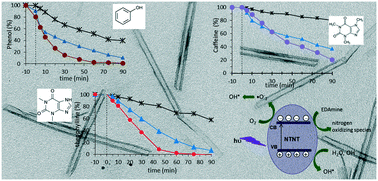当前位置:
X-MOL 学术
›
Environ. Sci.: Nano
›
论文详情
Our official English website, www.x-mol.net, welcomes your feedback! (Note: you will need to create a separate account there.)
Enhanced photocatalytic degradation of psychoactive substances using amine-modified elongated titanate nanostructures†
Environmental Science: Nano ( IF 7.3 ) Pub Date : 2017-11-28 00:00:00 , DOI: 10.1039/c7en00882a B. Barrocas 1, 2, 3, 4, 5 , M. C. Neves 5, 6, 7, 8, 9 , M. Conceição Oliveira 5, 10, 11, 12, 13 , O. C. Monteiro 1, 2, 3, 4, 5
Environmental Science: Nano ( IF 7.3 ) Pub Date : 2017-11-28 00:00:00 , DOI: 10.1039/c7en00882a B. Barrocas 1, 2, 3, 4, 5 , M. C. Neves 5, 6, 7, 8, 9 , M. Conceição Oliveira 5, 10, 11, 12, 13 , O. C. Monteiro 1, 2, 3, 4, 5
Affiliation

|
Many thousands of pharmaceuticals and personal care products (PPCPs) are used worldwide and disposed in the environment after use. Several removal methodologies have been proposed but clear improvements in effectiveness and efficiency are needed. In this work, new hybrid photocatalytic nanomaterials were obtained through sensitization of titanate nanotubes (TNT) and nanowires (TNW) with ethylenediamine (EDAmine). The prepared materials, NTNT and NTNW respectively, were morphologically, structurally, and optically characterized by XRD, TEM, DRS and XPS. No modifications in the structure and morphology were detected after EDAmine incorporation. However, an increase in the visible light absorption and in the point of zero charge was observed. The application of these novel hybrid nanomaterials in the catalytic photodegradation of emergent pollutants was studied. Terephthalic acid was used as a probe for hydroxyl radical photocatalytic production evaluation. The highest catalytic activity was achieved by the NTNT sample. The photocatalytic ability of the hybrid materials for the degradation of psychoactive substances, caffeine and theophylline, and for phenol removal was evaluated and the secondary products identified. After 60 min under UV-vis radiation, the NTNT sample was the best catalyst, achieving 98% photodegradation efficiency for phenol and theophylline and 60% for caffeine (20 ppm solutions). A mechanism for charge transfer in irradiated NTNT is proposed and discussed.
中文翻译:

使用胺修饰的细长钛酸酯纳米结构增强了对精神活性物质的光催化降解†
全球使用了数千种药品和个人护理产品(PPCP),使用后将其丢弃在环境中。已经提出了几种去除方法,但是需要在有效性和效率上进行明显的改进。在这项工作中,通过用乙二胺(EDAmine)敏化钛酸酯纳米管(TNT)和纳米线(TNW)获得了新的杂化光催化纳米材料。通过XRD,TEM,DRS和XPS对所制备的材料NTNT和NTNW分别进行形态,结构和光学表征。加入EDAmine后未检测到结构和形态的改变。然而,观察到可见光吸收和零电荷点的增加。研究了这些新型的杂化纳米材料在新兴污染物的催化光降解中的应用。对苯二甲酸用作羟基自由基光催化生产评估的探针。NTNT样品实现了最高的催化活性。评价了杂化材料对精神活性物质,咖啡因和茶碱的降解以及对苯酚的去除的光催化能力,并鉴定了副产物。在紫外线可见辐射下60分钟后,NTNT样品是最好的催化剂,苯酚和茶碱的光降解效率达到98%,咖啡因的光降解效率达到60%(20 ppm溶液)。提出并讨论了一种在受辐照的NTNT中电荷转移的机理。NTNT样品实现了最高的催化活性。评价了杂化材料对精神活性物质,咖啡因和茶碱的降解以及对苯酚的去除的光催化能力,并鉴定了副产物。在紫外线可见辐射下60分钟后,NTNT样品是最好的催化剂,苯酚和茶碱的光降解效率达到98%,咖啡因的光降解效率达到60%(20 ppm溶液)。提出并讨论了一种在受辐照的NTNT中电荷转移的机理。NTNT样品实现了最高的催化活性。评价了杂化材料对精神活性物质,咖啡因和茶碱的降解以及对苯酚的去除的光催化能力,并鉴定了副产物。在紫外线可见辐射下60分钟后,NTNT样品是最好的催化剂,苯酚和茶碱的光降解效率达到98%,咖啡因的光降解效率达到60%(20 ppm溶液)。提出并讨论了一种在受辐照的NTNT中电荷转移的机理。NTNT样品是最好的催化剂,苯酚和茶碱的光降解效率达到98%,咖啡因(20 ppm溶液)达到60%。提出并讨论了一种在受辐照的NTNT中电荷转移的机理。NTNT样品是最好的催化剂,苯酚和茶碱的光降解效率达到98%,咖啡因(20 ppm溶液)达到60%。提出并讨论了一种在受辐照的NTNT中电荷转移的机理。
更新日期:2017-11-28
中文翻译:

使用胺修饰的细长钛酸酯纳米结构增强了对精神活性物质的光催化降解†
全球使用了数千种药品和个人护理产品(PPCP),使用后将其丢弃在环境中。已经提出了几种去除方法,但是需要在有效性和效率上进行明显的改进。在这项工作中,通过用乙二胺(EDAmine)敏化钛酸酯纳米管(TNT)和纳米线(TNW)获得了新的杂化光催化纳米材料。通过XRD,TEM,DRS和XPS对所制备的材料NTNT和NTNW分别进行形态,结构和光学表征。加入EDAmine后未检测到结构和形态的改变。然而,观察到可见光吸收和零电荷点的增加。研究了这些新型的杂化纳米材料在新兴污染物的催化光降解中的应用。对苯二甲酸用作羟基自由基光催化生产评估的探针。NTNT样品实现了最高的催化活性。评价了杂化材料对精神活性物质,咖啡因和茶碱的降解以及对苯酚的去除的光催化能力,并鉴定了副产物。在紫外线可见辐射下60分钟后,NTNT样品是最好的催化剂,苯酚和茶碱的光降解效率达到98%,咖啡因的光降解效率达到60%(20 ppm溶液)。提出并讨论了一种在受辐照的NTNT中电荷转移的机理。NTNT样品实现了最高的催化活性。评价了杂化材料对精神活性物质,咖啡因和茶碱的降解以及对苯酚的去除的光催化能力,并鉴定了副产物。在紫外线可见辐射下60分钟后,NTNT样品是最好的催化剂,苯酚和茶碱的光降解效率达到98%,咖啡因的光降解效率达到60%(20 ppm溶液)。提出并讨论了一种在受辐照的NTNT中电荷转移的机理。NTNT样品实现了最高的催化活性。评价了杂化材料对精神活性物质,咖啡因和茶碱的降解以及对苯酚的去除的光催化能力,并鉴定了副产物。在紫外线可见辐射下60分钟后,NTNT样品是最好的催化剂,苯酚和茶碱的光降解效率达到98%,咖啡因的光降解效率达到60%(20 ppm溶液)。提出并讨论了一种在受辐照的NTNT中电荷转移的机理。NTNT样品是最好的催化剂,苯酚和茶碱的光降解效率达到98%,咖啡因(20 ppm溶液)达到60%。提出并讨论了一种在受辐照的NTNT中电荷转移的机理。NTNT样品是最好的催化剂,苯酚和茶碱的光降解效率达到98%,咖啡因(20 ppm溶液)达到60%。提出并讨论了一种在受辐照的NTNT中电荷转移的机理。


























 京公网安备 11010802027423号
京公网安备 11010802027423号